About Citrus Pages

Vangasay lemon
© Gene Lester
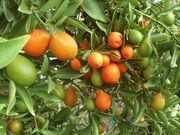
Indio
Mandarinquat
© Joe Real
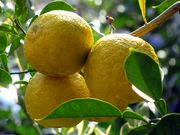
Yuzu
lemon © Laaz

Shasta Gold mandarin
© Jorma Koskinen
|
I
started Citrus Pages in 2006. I was looking for information on the
Internet about the most common citrus types with representative
pictures of
each variety. I found a lot of information on many sites but I missed a
comprehensive approach arranged by groups and species combined with
decent photographs. I could not find one. I thought long about creating
my own site but the crucial thing was how to obtain good pictures. I
wanted my site to differ from so many other citrus sites by having at
least one photo of each variety, more if
possible.
Before starting I wrote to some of
the biggest citrus research centres and universities around the world,
presented my plan and asked if they would agree to provide pictures for
my non-commercial site. I promised I would credit the organisation or
person holding
the copyright under each picture. To my surprise many agreed.
All
of them are listed on the Photos & links page.
My
first plan was to include the most common edible citrus fruits only,
around 200 varieties. The plan was completed early 2007 and I
was
happy with it. I soon received e-mail where people were
enthusiastic
about the site but asked questions like: "Why no kumquats?", "Where are
the Australian citrus?" I gave a deep sigh and was again
confronted
with the same problem. I have enough information but no
photos. Another round of e-mail went out and again I received many
replies. By early 2008 this site found its present form, then with
around 350
citrus varieties and included further groups like Papedas and
Trifoliate orange with other rootstock.
Thanks to research
centres like INRA Corsica, University of California Riverside, Texas
A&M University and many citrus growers and enthusiasts like
Gene
Lester, Joe Real and Laaz in
the United States and Mike Saalfeld and Petr Broža in Europe I have
many new high definition photographs. Citrus Pages has several citrus
varieties of which there previously was no information or
photo available on the Internet.
After
a four-week visit in January 2010 to central California where I was a
house guest of Gene Lester I now have a collection of 6000 citrus photographs
of which over 3000 are new pictures of my own. Gene took me to the UC
Lindcove Citrus Research Station with its collection of several hundred
citrus types and to many smaller growers and private gardens. It
took me a week in Gene's own orchard alone to take pictures of his
400+ citrus trees of nearly 200 different citrus types, which form the
largest private collection of citrus varieties. I shall now be able to
slowly go through the over 1500 pictures on Citrus Pages and replace
the oldest small pictures with bigger and technically better newer ones. |
Citrus fruits
| Combined
together the citrus family is the largest group of commercially grown
fruit. Bananas
come second, with grapes in third place. Citrus Pages
now also include Kumquats, Papedas, and Native
Australian
citrus as well as Trifoliate orange and other rootstock. More distant
citrus relatives also
have a page. There are 310 varieties
with a short description and a photograph. About 90 closely related
cultivars are mentioned
in
addition. Of
the 310 citrus types 131 have been assigned a botanical name
at
one
time or another. The botanical
index lists approximately 270
alternative Latin
names for them, each with its respective author. |
|
A little bit of history
The true story of the arrival of citrus to the West.



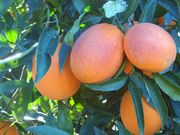
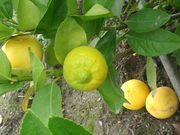
|
Citrons were grown in
Mesopotamia as early as 4000 B.C. Most
citrus types originated in the large areas of temperate climate around
the Himalayas or in south-east Asia. The first
written
mention of citrus fruit is found in Sanskrit literature around
800
B.C. The cultivation of citrus fruit presumably began in China around
500 B.C.
The first citrus brought to Europe was the citron,
which came with the army of Alexander the Great in 325 B.C.
from Persia.
The citron was first used as a perfume and an insecticide and was later
found
to be edible when properly prepared. The Romans imported
oranges and
lemons from their provinces as expensive luxuries for their
banquets. The
plants they grew in Rome survived but bore few fruit. There are
recognisable images of citrus fruit on the murals in Pompeii, which was
destroyed by a volcano in 79 A.D.
After the Romans citriculture in Europe fell into oblivion for
centuries. It is a common mistake repeated in a lot of citrus
literature that the first citrus fruit were brought to Europe by the
crusaders returning from Jerusalem in the 11th and 12th centuries. It
was the Arab conquerors who brought many cultural novelties, citrus
among
them, to southern Europe with their Holy War as early as the late
8th century. After they conquered southern Spain around 711
A.D. the Khalifs of Cordoba started building the then biggest
mosque in the world, the Mezquita of Cordoba in what they called Al-Andaluz. The building was completed in 987 when the famous Patio de los naranjos, the
courtyard of oranges also took its final form. The Caliphs of
Cordoba were very fond of sour orange trees and ordered them to be
planted in the most prominent public spaces of the most important
towns. This was the type that later
became the Standard sour orange or Seville orange.
Lemon and lime soon followed and after the conquest of Sicily we know
that all three fruits were grown on the island in the year 1002 A.D.
The crusaders did bring citrus fruit to the northern side of the
Mediterranean. They re-introduced the citron and also brought the lemon
and a type of sour orange that we now know as the bittersweet orange.
This is the type that first reached America and the royal courts
of Europe. The great voyages of
discovery
not only enlarged our view of the world but also introduced us to a
type of
sweet(er)
orange in the early 1500's. But it was not until 1635 that the
Portuguese planted a new type of citrus fruit they had found in China.
It was the first citrus type that could be eaten fresh, the kind that
we today know as the sweet orange, which for more than two centuries was called the Portugal orange.
On his second voyage Columbus introduced the first citrus fruits, the
bittersweet orange and lemon among them, to
America on
November 22, 1493 on the Island of Hispaniola. First
citrus plants
were planted in the continental America on the coast of
present-day Mexico
on July 12, 1518. Citrus fruit spread to Florida in 1565, South
Carolina in
1577, Arizona in 1707 and to California in 1769. It was in Florida and
later in Paraguay where the bittersweet orange soon escaped from
orchards and became naturalized still growing wild in many areas.
The last of the common citrus fruits to arrive in Europe and the U.S. was the
mandarin as
late as the beginning of the 19th century. Since then it has become one
of the
most popular citrus fruits and a source of continuous development and
breeding.
The research centre of the French Institute for Agricultural Research
on the
island of Corsica in the Mediterranean has more than 240 different
kinds of
mandarin trees.
|
2009
World citrus production |
|



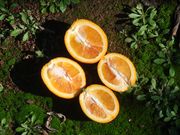


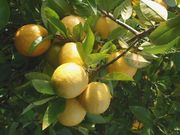 |
The total world citrus production for
the 2010/11 season is forecast at 58,3 million metric tons, 40% of
which is grown in China and consumed locally. The most recent
statistical data by country is available from the year 2009. The three
biggest producers remain the same but India has now reached the fourth
position ahead of Mexico and Spain.
| World citrus total production in 2009, mostly consumed domestically. |
|
|
|
|
| Country |
metric tons |
Country |
metric tons |
|
|
|
|
| China |
23 088 471 |
Greece |
1 009 956 |
| Brazil |
19 752 262 |
Algeria |
844 952 |
| United
States of America |
10 740 150 |
Peru |
809 714 |
| India |
8 128 393 |
Viet Nam |
623 576 |
| Mexico |
7 124 577 |
Republic of Korea |
621 382 |
| Spain |
5 240 100 |
Israel |
592 118 |
| Iran |
4 138 700 |
Ghana |
575 479 |
| Nigeria |
3 769 420 |
Venezuela |
511 206 |
| Italy |
3 745 000 |
Australia |
487 351 |
| Turkey |
3 513 771 |
Cuba |
420 383 |
| Egypt |
3 295 495 |
Tunisia |
419 416 |
| Argentina |
2 200 000 |
Lebanon |
392 000 |
| South
Africa |
2 186 042 |
Costa Rica |
390 951 |
| Pakistan |
2 132 000 |
Paraguay |
326 489 |
| Indonesia |
2 102 560 |
Guatemala |
315 983 |
| Morocco |
1 763 037 |
Chile |
297 000 |
| Thailand |
1 308 827 |
Honduras |
292 295 |
| Japan |
1 191 250 |
Portugal |
280 341 |
| Colombia |
1 167 531 |
Uruguay |
268 621 |
| Syrian
Arab Republic |
1 092 598 |
Belize |
266 127 |
| | | | | | Source: FAOSTAT, Food and Agriculture Organisation of the United Nations | In 2008 the biggest citrus exporters
were
1. Spain, 2. South Africa, 3. United States
(oranges, grapefruit, grapefruit juice, lemons and limes),
4.
Turkey, 5. Argentina, 6. China, 7. Mexico
and 8.
Morocco.
The biggest citrus importers
by far are the 27 EU countries whose main EU external imports come from
South Africa, Argentina, Morocco and Turkey. After the EU the biggest importers
are 2. Russia (mainly from Egypt, Turkey, South Africa, Spain) 3. United States (orange
juice,
lemons,
limes and mandarins), 4. Canada, 5.
Japan, 6.
Ukraine, 7. Hong Kong, 8.
Malaysia, 9. Switzerland
and 10. Indonesia.
(Source: USDA Foreign Agricultural Service:
Citrus World Markets and Trade, 4/2008.)
The biggest production areas of orange juice are Sao Paulo, Brazil and
Florida, US. The biggest orange juice consumers are U.S., EU,
Canada, Russia and Japan. A
new feature that has emerged in the last few decades is the year-round
availability of citrus fruit in the biggest consumer areas of
North America and Europe. Because of the development of new late
maturing cultivars the first ripe fruit of the new season are available
in South Africa, Argentina, Australia and Brazil before the
previous crops
are finished in the northern hemisphere. After six months the situation
is reversed.
It is important
to remember
that unlike most other commercially grown fruit the majority of the
citrus
fruits (oranges, mandarins, lemons, citrons and most grapefruit)
mature during the local winter. In Europe the high season is from
November to March. Including the early and late varieties the whole
season lasts from October to May. Citrus fruit of the tropical climate
(limes, pomelos and some grapefruit types) are an exception to this.
Some pomelos can bear four crops in a year and some limes are picked
once a month throughout the year.
|
Description of the
fruit
The actual
division into fifteen groups in this presentation is, however, that of
the present author and takes note of recent research
using molecular analysis. Sometimes the division into
groups is determined solely by the food use of each fruit. Thus the
fruits in
the lime group are not all closely related but form a
collection of several different kinds of citrus fruit that are used in
the kitchen in much the same way as limes. The same is true of
lemons. The
only completely homogeneous groups are pomelos, grapefruit and
sweet oranges, all of which contain cultivated varieties of only one
species
or hybrid.
Example:
Calamondin, Citrus
× microcarpa
Bunge
(example 1).
The botanical name
of each type is given first. The complete
scientific name of a plant
includes the name of the author,
the person who first described the
fruit and named it. Sometimes two authors are given: first the name in
brackets of the person who originally used the Latin name followed by
the
name of the person who later amended the description and reassigned the
name to the plant type in question. An author name is often
given as an abbreviation. Only
Carl
von Linné has an initial (L.) Where needed or available,
several
synonyms
of the botanical name are given (example 2).
For a detailed discussion of botanical names see Which
botanical name is the correct one? on the Citrus
classification page.
This
is
followed by a brief description of the fruit and its most common food
uses (example 3).
Common
names follow, first in
English, sometimes with local variations. These are followed
by the most common names in a handful of selected languages, when
available. The author is fully aware of the enormous range of
geographical variants. The Photos
& links page has links to several sites
presenting large indices of names of citrus types and cultivated
varieties in multiple languages. At the bottom of the
pictures the copyright owner of each photograph is credited (example 4). |

example 1

example 2

example 3

example 4 |
Google Language Tool

As a new feature from November 2009 a language selection tool is placed
at
the top of each page. This service is provided by Google
Translation and includes about 50 most common languages
of Citrus
Pages visitors. The translations are done by a
computer and are not always accurate but hopefully they make visiting
Citrus Pages easier for non-native English speakers.
Abbreviations
The following
abbreviations are used
in plant
names:
sp.
= species
ssp. = subspecies
syn.
= synonyms, other versions of the Latin or variety name
var.
= botanical variant
× =
hybrid
The × may
refer to a
single plant: Citrus
limon × Citrus
medica means that the fruit is a hybrid of
lemon and citron. An × may
also refer to a whole species: Citrus
× paradisi
is the Latin
name used of the grapefruit meaning that it is
a man-made hybrid (of pomelo and orange) and
cannot as
such be found in nature. The abbreviations of the selected languages are :
| DAN |
Danish |
IND |
some common Indian
languages |
| ENG |
English |
ITA |
Italian |
| FIN |
Finnish |
LAT |
Latin |
| FRA |
French |
SPA |
Spanish |
| GER |
German |
SWE |
Swedish |
|




|
Citrus Pages photo copyright
 Eureka lemon Eureka lemon
© Jorma Koskinen | Citrus Pages has at present about 1500 citrus-related
photos provided by over 35 institutions and individuals, many of whom
have taken photos for this site exclusively. Photos
may be downloaded for private use only. They may not be printed or
published on other websites without prior consent of the copyright
owner. I am contractually unable
to give permission to use photos owned or taken by third parties and
requests should be addressed to the copyright owner directly.
I can only authorize the use of my own photos and will do so for
certain non-commercial purposes. In this case a link or reference to
Citrus Pages is required and a credit to
© Jorma Koskinen
must be shown. Please send photo requests to Citrus
Pages.
More information on the sources of the photographs is
given
on the Photos
&
links page. | 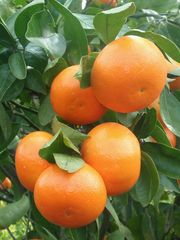
Daisy mandarin
© Jorma Koskinen |
Literature and
references
Much information
on citrus
fruits is available both in printed form as well as on the Internet.
I have made an effort to ensure that
the botanical information and classifications are as correct and
up-to-date as possible.
The botanical information used on Citrus Pages is based on the
following literature and it has been amended
and up-dated by the information from the recent scientific studies
listed at the bottom:
Editors: W. Reuther, H.J. Webber, L.D. Batchelor. University of
California Press © 1967
The magnum opus
of citrus
information unsurpassed in the wideness of its scope and the
thoroughness with which it handles its subject matter. Now available
also on the Internet.
Walter T.
Swingle and Philip C. Reece: The
Botany of Citrus and Its Wild Relatives. Chapter
3 of The
Citrus Industry Vol 1 pp 190 - 430. Originally published in 1943 this
is one of the best
known taxonomic descriptions of citrus fruit. Now also available in its
entirety on the Internet.
Robert
Willard Hodgson: Horticultural
Varieties of Citrus
Chapter 4 of The
Citrus Industry.
An extensive description of both common and rare cultivated varieties
of citrus.
Fresh Citrus Fruits. Edited by: W.F.Wardowski,
S. Nagy,
W.Grierson, Macmillan UK © 1986
Julia F.
Morton: Fruits
of Warm Climates,
Creative Resource Syst., Inc. Miami, FL. © 1987
A thorough
presentation of commercially important citrus types and their history,
cultivation and food uses. Available on the Internet.
R. Cottin:
Citrus
of the World,
A citrus directory, SRA - INRA - CIRAD © 2002 A
catalogue
of more than 5500 citrus names, classified by botanical, common and
cultivar names. Includes a useful comparison of Swingle and Tanaka
terminology listing equivalent names of both.
D.J. Mabberley:
The Plant-Book, Second edition, Oxford University Press © 1997
D.J. Mabberley:
The Plant-Book, Third edition, Cambridge University Press UK © 2008
James Saunt:
Citrus Varieties of the World,
Second edition, Sinclair UK © 2000, 160 pp
Tom McClendon: Hardy
Citrus for
the South East, Second edition, Southeastern Palm Society © 2006, 33 pp.
Michel Courbouleuz: Les agrumes, Rustica éditions, Paris © 2005, 119 pp.
Martin Page: Growing citrus, the essential gardener's guide,Timber Press, London © 2008, 192 pp.
Bernhard Voss: Zitruspflanzen, Kosmos, Stuttgart © 2009, 77 pp.
Bénédict et Michel Bachès: Agrumes, Ulmer, Paris, nouvelle édition augmentée © 2011, 128 pp.
University of California, Riverside Citrus
Variety Collection, Citrus
varieties
A presentation of the most important common varieties at the UCR
Experiment Station.
University of California, Riverside CCPP
Citrus Clonal Protection Program, Variety
data
A presentation of the holdings of the CCPP
citrus variety collection with the relevant data.
Répartition des variétés par espèces.
Station de recherche agronomique
SRA-INRA Corse.
Détails des variétés par espèces.
Station de recherche agronomique
SRA-INRA Corse.
These two large databases detail the holdings of the
INRA Citrus
Research Station in Corsica, France.
A
classification for
edible Citrus
D.J.
Mabberley, Rijksherbarium, University of Leiden, Netherlands
and
Royal BotanicGardens, Mrs Macquaries Road,
Sydney,
NSW 2000,
Australia (1997) Telopea 7(2): 167–172.
RFLP analysis of the origin of Citrus bergamia, Citrus
jambhiri,
and Citrus
limonia
Federici, C.T., Roose, M.L. and Scora, R.W.
2000. Acta Hort. (ISHS) 535:55-64
Citrus
phylogeny and genetic origin of important species as investigated by
molecular markers
E. Nicolosi, Z. N. Deng, A. Gentile, S. La Malfa,
G. Continella and E. Tribulato
Istituto di Coltivazioni arboree, University of
Catania, Italy. Theoretical and Applied Genetics 100(8): 1155-1166.
Australian
Citreae with notes on other Aurantioideae (Rutaceae)
Mabberley, D.J. Rijksherbarium,
University of
Leiden, Netherlands and Royal Botanic Gardens,
Mrs Macquaries Road,
Sydney, NSW 2000, Australia (1998) Telopea 7(4):333–344.
CITRUS
Linnaeus, Sp. Pl. 2: 782. 1753.
Zhang Dianxiang, David J. Mabberley, Fl. China 11:
90–96. 2008.
CHEMICAL
CONSTITUENTS OF ESSENTIAL OILS FROM THE RUTACEAE FAMILY
M. A. Nor Azah, J. Abdul Majid, S. Abu Said , M. Z. Zaridah
& Z.
Mohd. Faridz
Forest Research Institute
Malaysia (FRIM)
Molecular
characterization and genetic diversity among
Japanese acid citrus based on RAPD markers
A.
Asadi Abkenar and S. Isshiki 2002. Laboratory of Biotechnology and
Plant
Breeding, Saga University, Japan.
Journal
of Horticultural Science & Biotechnology (2003)
78
(1)
108-112
Native
Australian Citrus – wild species, cultivars and hybrids
Primary Industries and Resources, Government of South
Australia (PIRSA)
FS No: 7/03
The
International
Plant Names Index (IPNI) database of authors.
Assessment
of polyembryony in lemon: rescue and in vitro culture of immature
embryos
O. Pérez-Tornero and I. Porras
Instituto Murciano de Investigación y Desarrollo
Agrario y
Alimentario, C/ Mayor s/n, 30150 Murcia, Spain
Plant Cell, Tissue and Organ Culture 2008, 93:
173-180
Studies
on Polyembryony and Improvement of Breeding Efficiency of Oranges.
Hwang A-shiang and Yeuh Ching-shi.
Polyembryony in Citrus
Accumulation of Seed Storage Proteins in Seeds and
in
Embryos Cultured in Vitro
Anna M. Koltunow, Tetsushi Hidaka and Simon P.
Robinson
Plant Physiol. (1 996) 11 O: 599-609
Marker
enrichment and construction of haplotype-specific BAC contigs for the
polyembryony genomic region in Citrus
Michiharu Nakano, Tokurou Shimizu, Hiroshi Fujii, Takehiko
Shimada,Tomoko Endo, Hirohisa Nesumi, Takeshi Kuniga and Mitsuo Omura
Breeding Science Vol. 58 (2008) , No. 4 375-383
Polyembryony
and identification of Volkamerian lemon zygotic and nucellar seedlings
using RAPD
María Andrade-Rodríguez, Angel Villegas-Monter,
Guillermo
Carrillo-Castañeda, and Armando García-Velázquez.
Pesq. agropec. bras., Brasília, v.39, n.6,
p.551-559, jun.
2004
Performance
of various grapefruit (Citrus paradisi Macf.) and pummelo (C. maxima
Merr.) cultivars under the dry tropic conditions of Mexico
Becerra-Rodríguez
Salvador (1) ; Medina-Urrutia Víctor Manuel (1) ; Robles-González
Marciano Manuel (1) ; Williams Timothy (2)
Euphytica Y. 2008, vol. 164, No. 1, pages 27-36 [10 pages]
[bibl. : 3/4 p.]
|












|
Web optimisation
Citrus Pages are optimised for a minimum screen resolution width of 1280 pixels on Google Chrome and Firefox. On narrower screen settings photos may not coincide with the text.
The design and
compilation of Citrus Pages are mine.
Comments and suggestions are welcome.
Have fun!
Jorma Koskinen
e-mail
to Citrus
Pages
These
are my principles. If you don't like them, I have others. (Groucho
Marx)
|









































